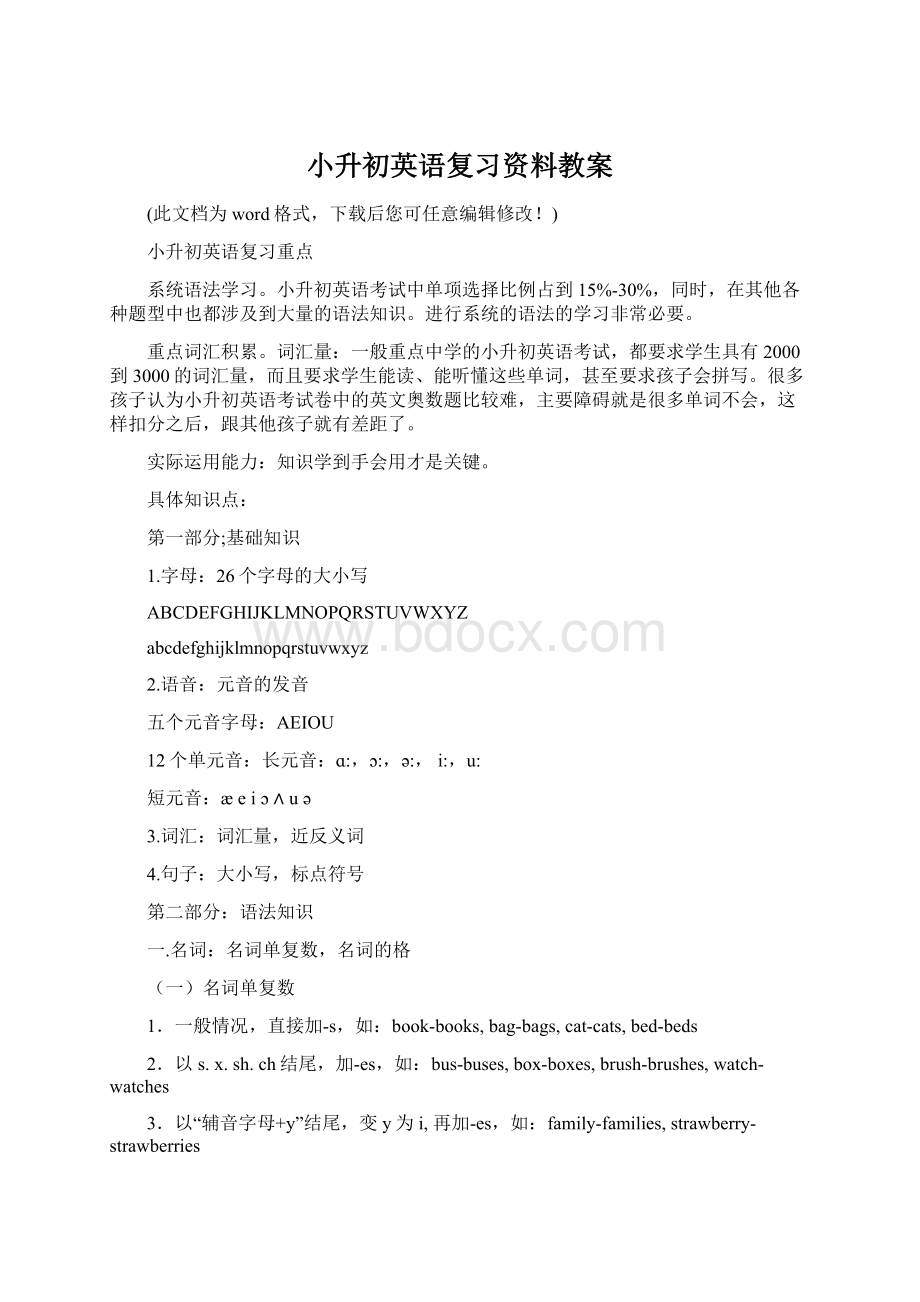小升初英语复习资料教案Word下载.docx
《小升初英语复习资料教案Word下载.docx》由会员分享,可在线阅读,更多相关《小升初英语复习资料教案Word下载.docx(14页珍藏版)》请在冰豆网上搜索。

长元音:
ɑ:
,ɔ:
,ə:
,i:
,u:
短元音:
æ
eiɔ∧uə
3.词汇:
词汇量,近反义词
4.句子:
大小写,标点符号
第二部分:
语法知识
一.名词:
名词单复数,名词的格
(一)名词单复数
1.一般情况,直接加-s,如:
book-books,bag-bags,cat-cats,bed-beds
2.以s.x.sh.ch结尾,加-es,如:
bus-buses,box-boxes,brush-brushes,watch-watches
3.以“辅音字母+y”结尾,变y为i,再加-es,如:
family-families,strawberry-strawberries
4.以“f或fe”结尾,变f或fe为v,再加-es,如:
knife-knives
5.不规则名词复数:
1kejian
man-men,woman-women,policeman-policemen,policewoman-policewomen,mouse-mice
child-children,foot-feet,tooth-teeth,fish-fish,people-people,Chinese-Chinese,Japanese-Japanese
不可数名词的复数就是原型:
paper,juice,water,milk,rice,tea
(二)名词的格
(1)有生命的东西的名词所有格:
a)单数后加’s如:
Lucy’srulermyfather’sshirt
b)以s结尾的复数名词后加’如:
’sshoes
●并列名词中,如果把’s加在最后一个名词后,表示共有,如:
TomandMike’scar汤姆和迈克共有的小汽车
●要表示所有物不是共有的,应分别在并列名词后加’s
Tom’sandMike’scars汤姆和麦克各自的小汽车
(2)表示无生命东西的名词通常用“of+名词”来表示所有关系:
如:
apictureoftheclassroomamapofChina
二.冠词:
不定冠词,定冠词种类:
(1)不定冠词:
aanaunitanuncle
元音开头的可数名词前用an:
anegganappleanorangeaneraseranansweranIDcardanalarmclockanactoranactressane-mailanaddressaneventanexampleanoperaanoldmananinterestingbookanexcitingsportanactionmovieanartlesson
(2)定冠词:
thetheeggtheplane
2.用法:
定冠词的用法:
(1)特指某(些)人或某(些)物:
Therulerisonthedesk.
(2)复述上文提到的人或物:
He’tatschool.
(4)在序数词前:
John’sbirthdayisFebruarythesecond.
(5)用于固定词组中:
inthemorningafternoonevening
不用冠词的情况:
(1)专有名词前:
Chinaisabigcountry.
(2)名词前有定语:
this,that,my,your,some,any,no等:
Thisismybaseball.
(3)复数名词表示一类人和事:
Monkeyscan’tswim.Theyareteachers.
(4)在节日,日期,月份,季节前:
TodayisChristmasDay.It’sSunday.
(5)一日三餐前:
Weplayfootballafterclass.Heplayschessatatnightbybus
第一课件网
三、代词:
人称代词,物主代词
人称代词
物主代词
主格
宾格
第一
人称
单数
I(我)
me
my(我的)
复数
we(我们)
us
our(我们的)
第二
you(你)
you
your(你的)
you(你们)
your(你们的)
第三
he(他)
his(他的)
she(她)
her
her(她的)
it(它)
it
its(它的)
they(他们她们它们)
them
their(他们的她们的它们的)
四、形容词,副词:
比较级,最高级
(一)、形容词的比较级
1、形容词比较级在句子中的运用:
两个事物或人的比较用比较级,比较级后面一般带有单词than。
比较级前面可以用more,alittle来修饰表示程度。
than后的人称代词用主格(口语中可用宾格)。
2.形容词加er的规则:
⑴一般在词尾加er;
⑵以字母e结尾,加r;
⑶以一个元音字母和一个辅音字母结尾,应双写末尾的辅音字母,再加er;
⑷以“辅音字母+y”结尾,先把y变i,再加er。
3.不规则形容词比较级:
good-better,beautiful-morebeautiful
(二)副词的比较级
1.形容词与副词的区别(有be用形,有形用be;
有动用副,有副用动)
⑴在句子中形容词一般处于名词之前或be动词之后
⑵副词在句子中最常见的是处于实义动词之后
2.副词比较级的变化规则基本与形容词比较级相同(不规则变化:
well-better,far-farther)
五数词:
基数词,序数词一、基数词
(1)1-20
one,two,three,four,five,six,seven,eight,nine,ten,eleven,twelve,thirteen,fourteen,fifteen,sixteen,seventeen,eighteen,nineteen,twenty
(2)21-99先说“几十”,再说“几”,中间加连字符。
23→twenty-three,34→thirty-four,45→forty—five,56→fifty-six,67→sixty-seven,78→seventy-eight,89→eighty-nine,91→ninety-one
(3)101—999先说“几百”,再加and,再加末两位数或末位数;
586→five,第三个“,”前为billion
1,001→onethousandandone
18,423→eighteenthousand,fourtwo
二、序数词
(1)一般在基数词后加th
eg.four→fourth,thirteen→thirteenth
(2)不规则变化
one→first,two→second,three→third,five→fifth,eight→eighth,nine→ninth,twelve—twelfth
(3)以y结尾的十位整数,变y为ie再加th
twenty→twentieth,forty→fortieth,ninety→ninetieth
(4)从二十一后的“几十几”直至“几百几十几”或“几千几百几十几”只将个位的基数词变为序数词。
twenty-first,two,on,at,behind等
1.at表示时间概念的某一个点。
(在某时刻、时间、阶段等)。
at1:
00(dawn,midnight,noon)在一点钟(黎明、午夜、中午)
2.on
1)表示具体日期。
注:
(1)关于"
在周末"
的几种表示法:
at(on)theweekend在周末---特指
at(on)weekends在周末---泛指
overtheweekend在整个周末
duringtheweekend在周末期间
(2)在圣诞节,应说atChristmas而不说onChristmas
2)在(刚……)的时候。
Onreachingthecity
1)表示"
时段"
、"
时期"
,在多数情况下可以和during互换,前者强调对比,后者强调持续。
in(during)1988(December,the20thcentury)在一九八八年(十二月、二十世纪)
七、动词:
动词的四种时态:
(1)一般现在时:
一般现在时的构成
1.be动词:
主语+be(am,is,are)+其它。
如:
Iamaboy.我是一个男孩。
2.行为动词:
主语+行为动词(+其它)。
如:
WestudyEnglish.我们学习英语。
当主语为第三人称单数(
第三部分:
句法
1.陈述句
(1)肯定句:
是指用肯定的语气来陈述的句子,如:
I’mastudent.Sheisadoctor.Heworksinaourclassroom.Hewilleatlunchat12:
00.IwatchedTVyesterdayevening.
(2)、否定句:
含有否定词或表示否定意义词的句子,如:
I’mnotastudent.Sheisnot(isn’t)adoctor.
Hedoesnot(doesn’t)workina’t)fourfansinourclassroom.
Hewillnot(won’t)eatlunchat12:
00.Ididnot(didn’t)watchTVyesterdayevening.
2.疑问句
一般疑问句:
是指询问事实的句子,此类句子必须用“yes”,或“no”来回答。
特殊疑问句:
以特殊疑问词(what,where,who,which,when,whose,why,
pencil
pencil-case
book
bagruler
eraser
crayon
sharpener
school
blue
purple
white
black
orange
pink
browncat
dog
monkey
panda
rabbit
ducksquirrel
mouse
elephant